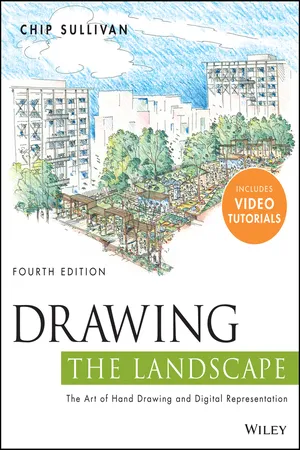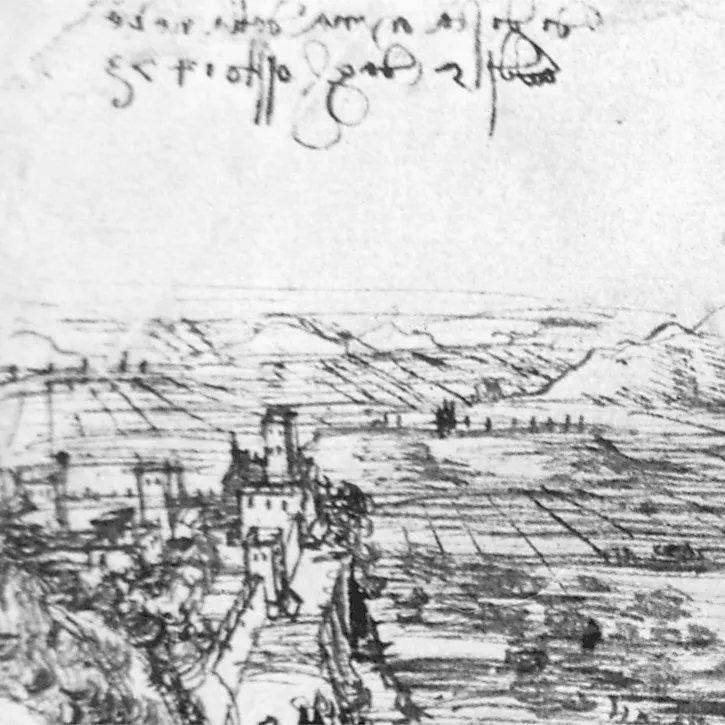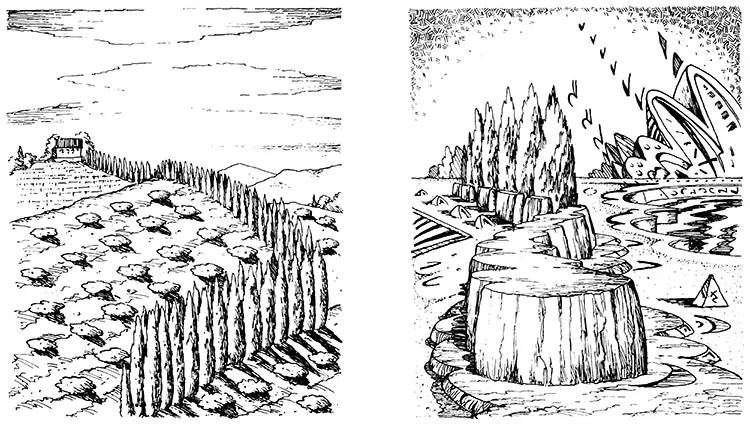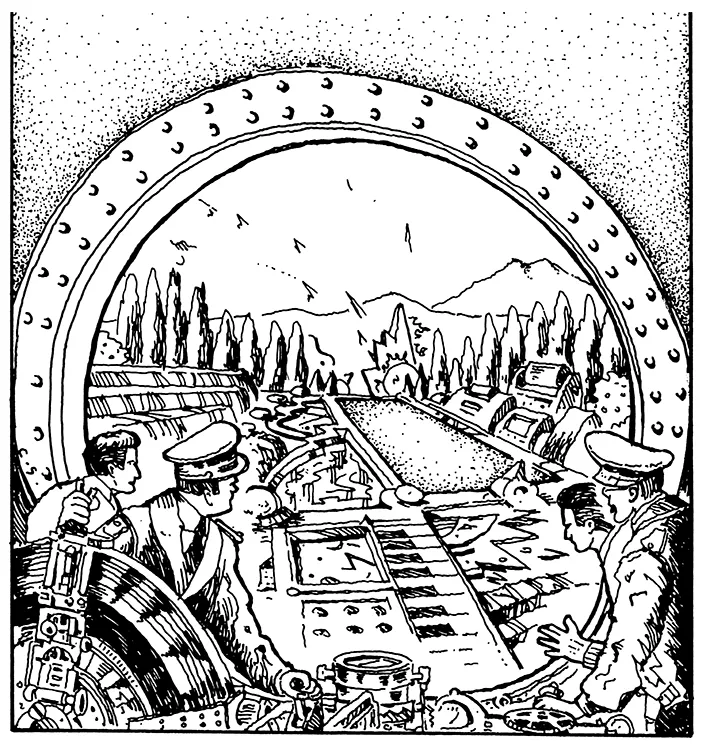
- English
- ePUB (mobile friendly)
- Available on iOS & Android
eBook - ePub
Drawing the Landscape
About this book
This elegant Fourth Edition of Chip Sullivan's classic Drawing the Landscape shows how to use drawing as a path towards understanding the natural and built environment. It offers guidance for tapping into and exploring personal creative potential and helps readers master the essential principles, tools, and techniques required to prepare professional graphic representations in landscape architecture and architecture. It illustrates how to create a wide range of graphic representations using step-by-step tutorials, exercises and hundreds of samples.
Frequently asked questions
Yes, you can cancel anytime from the Subscription tab in your account settings on the Perlego website. Your subscription will stay active until the end of your current billing period. Learn how to cancel your subscription.
No, books cannot be downloaded as external files, such as PDFs, for use outside of Perlego. However, you can download books within the Perlego app for offline reading on mobile or tablet. Learn more here.
Perlego offers two plans: Essential and Complete
- Essential is ideal for learners and professionals who enjoy exploring a wide range of subjects. Access the Essential Library with 800,000+ trusted titles and best-sellers across business, personal growth, and the humanities. Includes unlimited reading time and Standard Read Aloud voice.
- Complete: Perfect for advanced learners and researchers needing full, unrestricted access. Unlock 1.4M+ books across hundreds of subjects, including academic and specialized titles. The Complete Plan also includes advanced features like Premium Read Aloud and Research Assistant.
We are an online textbook subscription service, where you can get access to an entire online library for less than the price of a single book per month. With over 1 million books across 1000+ topics, we’ve got you covered! Learn more here.
Look out for the read-aloud symbol on your next book to see if you can listen to it. The read-aloud tool reads text aloud for you, highlighting the text as it is being read. You can pause it, speed it up and slow it down. Learn more here.
Yes! You can use the Perlego app on both iOS or Android devices to read anytime, anywhere — even offline. Perfect for commutes or when you’re on the go.
Please note we cannot support devices running on iOS 13 and Android 7 or earlier. Learn more about using the app.
Please note we cannot support devices running on iOS 13 and Android 7 or earlier. Learn more about using the app.
Yes, you can access Drawing the Landscape by Chip Sullivan in PDF and/or ePUB format, as well as other popular books in Architecture & Urban Planning & Landscaping. We have over one million books available in our catalogue for you to explore.
Information
Chapter One
The Essence of Drawing
start graphic
Drawing turns the creative mind to expose its workings. Drawing discloses the heart of visual thought, coalesces spirit and perception, conjures imagination; drawing is an act of meditation, an exorcism of disorder; a courting of artistic ideas; above all it is the lean instrument of visual formation and the vortex of artistic sensibility.
Edward Hill
The Language Of Drawing
start figure The Language Of Drawing

Figure 1-1: One of da Vinci’s first known drawings of the Tuscan landscape, dated 1473. The artist was 21 when he made this drawing, entitled “Day of St. Mary of the Snows,” which has been called “the first true landscape drawing in Western art.” (Bramly, 1991, 84 ©EMB-Service, Lucerne, Switzerland)
Why do we draw? We draw because it is the act of seeing and thinking clearly. It is an integral part of the creative process, and the ultimate design tool. Carlo Scarpa, an Italian architect, best summed this up when he said, “I draw so I can see.” By moving from elevation to perspective, from plan to bird’s-eye view, drawing elucidates our three-dimensional world. When I was just starting out, I remember watching my mentor, landscape architect and artist Frank James, pick up a pencil and move it across a sheet of paper; it was like watching an angel fly. Frank’s facility for drawing was incredibly inspiring and a thing to behold. His ability to use drawing as an expressive design tool was marvelous.
Drawing allows a concept to evolve. It resides between freedom and structure: the freedom of ideas versus the physical structure that orders our representations of space. It provides the potential to create realistic images.
Drawing can also be a meditation. It can take you into other worlds, creating a transcendent experience. One of the constant themes of Zen art is the expression of the artist’s own inner state of going nowhere in a timeless dimension.
Definition of Drawing
start figure
Figure 1-2: Ink on vellum. Drawing allows thinking in three dimensions.
Artist and teacher Edward Hill stated, “Drawing is the act of making a mark, line, or incision on a surface; and in the larger sense, a participation in the language” (1966, 8). A beautifully drawn, pure line arching across a page is a wonder to behold. It can vary from divine simplicity to dynamic movement. Drawing is a tool of exploration, and a single stroke can express thought. The artist or designer imbues line with personality and thus becomes an inventor. Through drawing, artists are continually redefining themselves and creating a personal image of reality.
The beginning of each drawing is the start of an exciting new trip; when you begin, your line takes off on a journey without a map. Learning to draw can be the beginning of a creative journey that can last a lifetime. From the moment of inception to the creation of the image, every drawing has the potential to express an idea. To begin to draw requires initiative; the act of drawing is directed intuition. Charles Burchfield, one of the greatest painters of the American scene, felt that the best drawing was a spontaneous creation. Spontaneity allows an incredible pictorial and emotional range, providing access to imaginative wanderings. If you can capture this spontaneous quality in your drawings, you can make them come alive.
start figure 
Figure 1-3: Frank James, Sasaki Associates. Drawing as expression.
The development of your freehand drawing skills will help you to understand and graphically describe the environment. It is a means of investigating nature and a tool for designing entirely new ecosystems. As artist and teacher Hans Hofmann said, “The artist is an agent in whose mind nature is transformed into a new creation” (1967, 70).
start figure 
Figure 1-4: Charles Burchfield. Old Gnarled Tree in a Field. Pencil on paper. 17" × 22". (Courtesy Kennedy Galleries, Inc., New York City)
The beauty of a drawing is that you make it with your own hands; its success or failure rests entirely with you. If you develop a love for drawing, it will be reflected in your work and revealed to others. To achieve this, try to make each line you draw able to stand alone as a beautiful mark. Before beginning, empty your mind of all other thoughts. Think of yourself as an actor about to go onstage and perform. Slow down, breathe deeply, and think carefully about what you are about to do; it is an emotional response. Grasp the essence of your subject and your drawings will become your greatest teacher. You can learn much from them. Learning to relax will facilitate your ability to draw freely. Eventually you may find that drawing itself will become a method of relaxation.
You should work on each of the exercises in this book until you feel comfortable with the results. When you begin to feel pleased with the results of one exercise, go on to the next one. You can also go back and work on several at the same time.
When concentrating, you can become part of the drawing, getting inside it. Concentration is required to avoid getting into a rut, and to push yourself to evolve through experimentation. After developing a successful style, many people just replicate it again and again. Always try to improve your technique; otherwise you’ll just keep repeating your mistakes. When I was in school, I was told that I might have been a good artist once, but I had become lazy and was no longer innovative. That comment lit a fire under me. As Frank James said, when you draw you should always try to “seek the truth, speak the truth, be the truth.”
start figure 
Figure 1-5: Chip Sullivan. Double Imperative Landscape. Pen and ink on paper. Composing the landscape with extraordinary arrangements.
Learning to draw can be a baffling, frustrating experience. It will make you angry, but don’t give up. Once you begin to produce satisfying drawings it will be an incredible natural high. Everything you put into your drawing will be returned to you. You can learn to draw, but you must first believe that you can. When Frank James was an architecture undergraduate at the University of Washington in 1962, he learned to draw by being inspired by such students as Laurie Olin. According to Frank, “Laurie Olin could draw like Walt Disney on psilocybin on an off day.” Today Laurie is not only an award-winning landscape architect but a master landscape artist. Frank forced himself to learn, and the results are wonderful. Ultimately, to inspire others to draw you will have to draw convincingly and beautifully. In a sense, you are combining ordinary things into extraordinary arrangements. Stop looking and start feeling your environment; strive toward meaning by drawing from within your psyche. Drawing is a bridge between perception and thinking. As Cennino Cennini, fifteenth-century artist and author, stated,
Do not fail, as you go on, to draw something every day, for no matter how little it is, it will be well worthwhile, and will do you a world of good. (Hill, 1966, 108)
start feature Exercise 1-1: Automatic Writing
The surrealists realized that writing is similar to drawing, in that it is mark-making, and developed this method to link the hand with the stream of consciousness. Begin by finding a comfortable, quiet spot in which to work. Take a pencil and a stack of loose paper and set them down in front of you. Clear your mind and relax. Quickly begin to write whatever comes into your mind. Do not worry about spelling or grammar. Let the words and sentences generate themselves. Try to suspend your rational thoughts. Do this for about thirty minutes a day for a week, or until it becomes second nature. You could also expand this exercise into a useful journal.
Drawing as Conceptualizing
All great works of art evolve from a concept. Setting ideas into drawn form breathes life into them, allowing you to dip into the vast space of ideas. From the inception of an idea to its final drawn form, drawing plays an integral part in the creative process. Drawing is a conceptual tool that brings quick form to the flow of ideas.
Sometimes a designer will produce hundreds of conceptual drawings until striking the right form for the idea. These forms develop into thumbnail sketches and then into design development drawings. The final idea will then be rendered as a highly finished illustrative drawing.
Drawing as Seeing
Landscape drawing is not the reproduction of nature. It is an expression of the emotions, sensations, and feelings that the landscape impresses on the artist. It is the creation of atmosphere and space.
Drawing a landscape allows you to visualize it in a new way. As opposed to taking a photograph, drawing a landscape enables you to really understand it. There is something unique about the hand-eye relationship as you record a subject through drawing. Drawing links your visual perceptions to your subconscious. The photographed image preserves the visual event, but drawing entails the experience of looking: we stop and become part of the subject and its time. Strive toward eliminating the separation between you and the image.
start figure 
Figure 1-6: Pen and ink on paper. Conceptual design studies.
You must be persistent to capture the secrets of landscape drawing. Through the excitement of the moving hand you become part of the mystery of creation. But in order to produce excellent drawings you must have something to say. By dedicating yourself to drawing you will inform your imagination. Increasing your awareness will lead to your own form of expression. By combining imagination, visualization, and drawing, you will invent new landscapes.
start figure 
Figure 1-7: Pen and ink on paper. Discovering new ways to visualize the landscape.
It takes passion to attain this level of awareness. Even though Charles Burchfield had...
Table of contents
- Cover
- Preface
- Chapter One: The Essence of Drawing
- Chapter Two: The Daybook
- Chapter Three: The Creative Environment
- Chapter Four: Equipment and Drawing Instruments
- Chapter Five: Preliminary Drawing Exercises
- Chapter Six: Tone and Texture
- Chapter Seven: Drawing Techniques for Trees and Plants
- Chapter Eight: Composing the Landscape Drawing
- Chapter Nine: Freehand Perspective Drawing
- Chapter Ten: Drawing the Landscape in Plan, Elevation, and Section
- Chapter Eleven: Axonometric and Isometric Landscape Drawing
- Chapter Twelve: Animating the Landscape: Visual Narratives, Storyboards, and Moving Drawings
- Chapter Thirteen: The Hybrid Drawing
- Chapter Fourteen: The Art of Presentation
- Conclusion
- Afterword
- References
- Supplemental Images
- Index